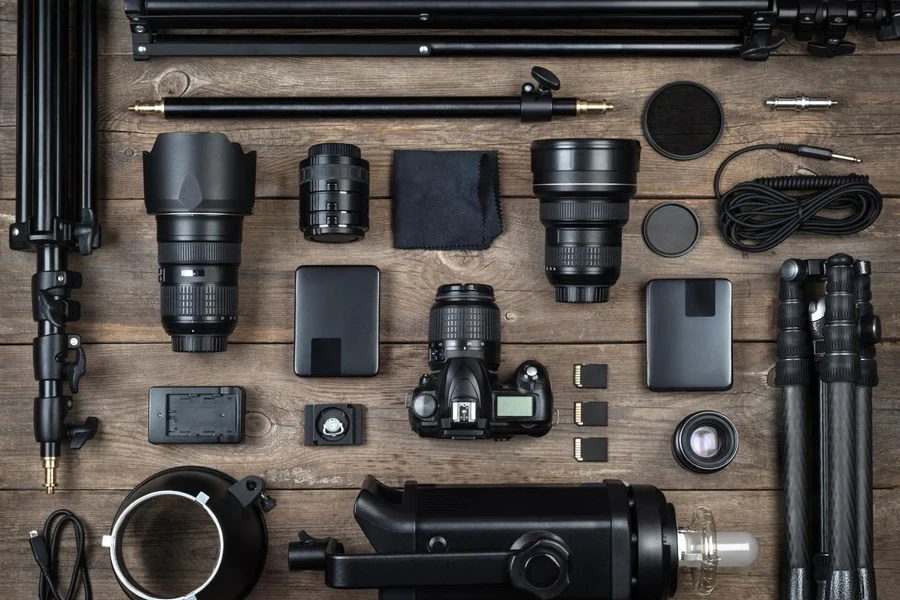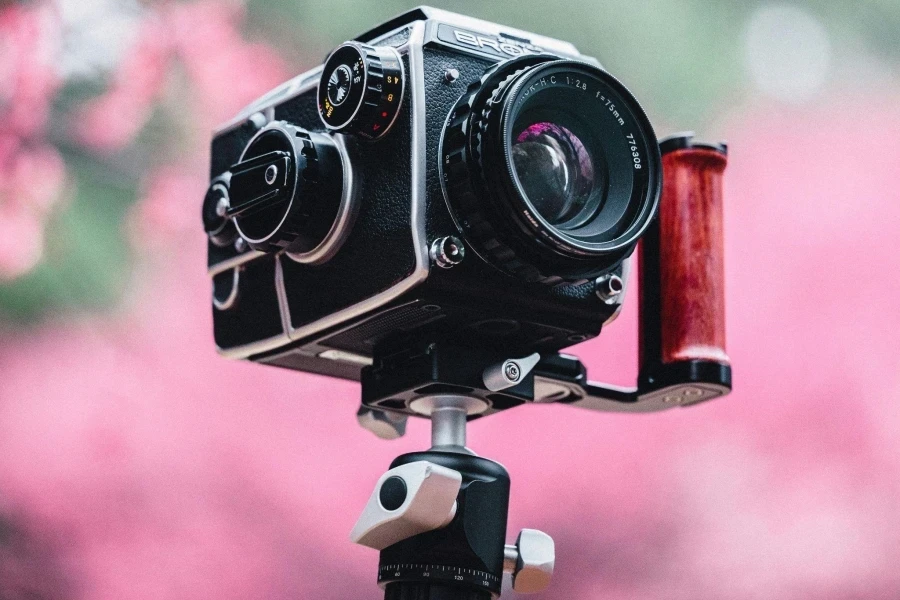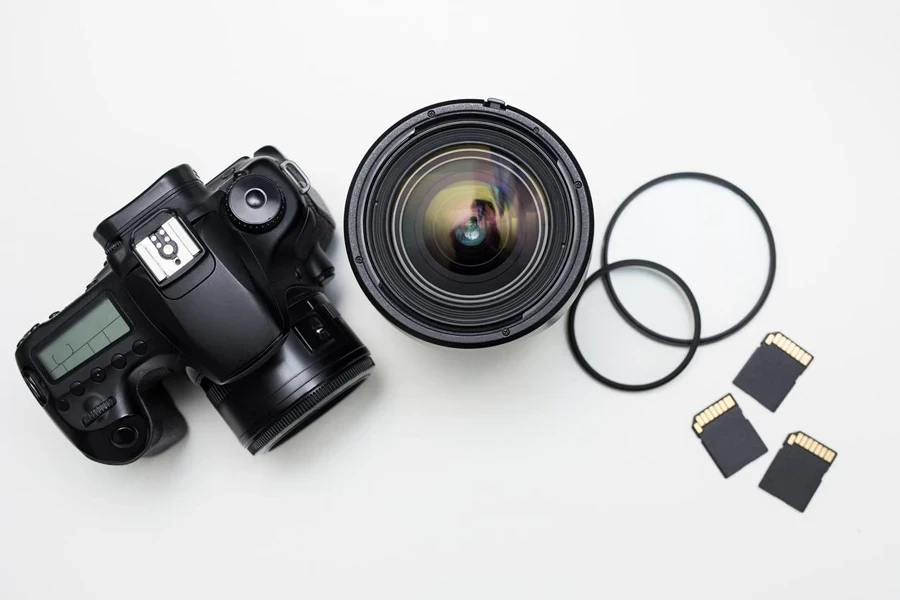As 2024 unfolds, advancements in camera accessories continue to transform photography. These tools, essential for capturing high-quality images, range from stabilizing tripods to filters that enhance clarity and color. Technological innovations simplify photographic techniques and expand creative possibilities, emphasizing the importance of selecting the right accessories to keep pace with a rapidly evolving industry.
Table of Contents
1. Exploring the spectrum of camera accessories
2. Snapshot of the 2024 camera accessory market
3. Key considerations for choosing the right accessories
4. Spotlight on 2024’s top camera accessories
Exploring the spectrum of camera accessories

Essential gear for every photographer: Camera accessories form the backbone of enhanced photographic capabilities, offering a range of tools that cater to both safety and technical precision. Safety tools like rugged camera cases and protective lens covers safeguard equipment from environmental hazards, while advanced lens filters and external lighting solutions significantly uplift the quality of captured images. These essentials ensure that the camera operates at peak efficiency and is shielded from unexpected damages, thereby maintaining its longevity and performance.
Breakthroughs in photographic support: Recent innovations have notably reshaped the field of photography, introducing a slew of advanced support tools that enhance both the convenience and quality of photo shoots. Cutting-edge tripods not only offer remarkable stability but also come with features like flexible legs and automated angle adjustments, catering to a wide range of shooting environments from rugged outdoors to controlled studio settings. Similarly, remote shutters and ergonomic grips have revolutionized the way shots are captured, providing photographers with the ability to shoot from difficult angles without compromising on image stability. These advancements not only streamline the photographic process but also open up new possibilities for creative expression.
These sections of the camera accessories spectrum demonstrate a dynamic integration of tradition and innovation, ensuring that every photography professional can find tools that enhance their craft and adapt to evolving technological landscapes. Whether through basic protective gear or through advanced shooting aids, the right accessories play a crucial role in defining the photographic results and operational ease.
Snapshot of the 2024 camera accessory market

Technological innovations propel market expansion: Experts currently value the camera accessories market at approximately US$ 8.1 billion, and they project it to reach about US $12.2 billion by the end of 2032. They estimate this growth will occur at a compound annual growth rate (CAGR) of approximately 8.3% from 2024 to 2032. This forecasted growth is driven by increased adoption across various photography genres and the continual introduction of innovative products that enhance photographic capabilities and user experience. In 2024, the camera accessory market is witnessing a significant transformation driven by technological advancements. Wireless technologies have become a staple in new camera accessories, offering users unprecedented ease and flexibility in controlling their photography gear from a distance. Additionally, artificial intelligence (AI) is now more deeply integrated into camera systems, enhancing functionalities such as image stabilization, automatic scene recognition, and real-time photo editing. These innovations are not just improving the quality of photography but are also making sophisticated techniques more accessible to a broader range of photographers.
Shifting trends in consumer preferences: Alongside technological advancements, there is a noticeable shift in consumer preferences that is shaping the demand for new and advanced camera accessories. Photographers, both amateur and professional, are increasingly seeking accessories that offer not only high performance but also portability and ease of use. Preferences are shifting towards lightweight, compact equipment that does not compromise on functionality. This trend is particularly evident in the rising popularity of mobile-compatible lenses and travel-friendly lighting kits, which cater to the growing segment of mobile and travel photographers looking for professional-quality results from compact devices.
These evolving trends indicate a dynamic and growing market where the demand for innovative, user-friendly camera accessories is set to rise. Manufacturers are responding with products that blend traditional functionality with modern technology, setting new standards in the photography accessory industry.
Key considerations for choosing the right accessories

Ensuring compatibility and adaptability: Selecting camera accessories that are compatible across various camera models and adaptable to multiple photography styles is crucial in today’s diverse photographic environment. For instance, universal lens adapters allow photographers to use a wide array of lens brands on different camera bodies, thus maximizing the utility of their existing lenses without being restricted by brand-specific mount limitations. Similarly, modern tripods now feature adaptable heads that can switch between configurations suitable for video and still photography, thereby accommodating the dual needs of dynamic shooting scenarios.
Further, with the increasing popularity of hybrid shooting (both video and photos), accessories like microphones and lighting rigs that are compatible with a range of camera setups become indispensable. Features like Bluetooth connectivity for remote controls and app-integrated functionalities are becoming standards for enhancing adaptability, allowing photographers to manage their shoots more flexibly and efficiently.
Prioritizing durability and excellence: Durability in camera accessories is not just about the ability to withstand physical stress but also about maintaining performance over time under various environmental conditions. For example, carbon fiber tripods offer a superb balance between strength and weight, making them ideal for photographers who work in rugged, outdoor environments. These tripods resist corrosion and are less prone to wear in sandy or salty air conditions compared to their aluminum counterparts.
Camera bags are another critical area where durability plays a pivotal role. High-quality camera bags are now made from weather-sealed materials that offer protection against rain, dust, and mechanical impacts. Brands like Lowepro and Pelican are renowned for their rugged designs that provide secure storage solutions with reinforced padding and water-resistant coatings.
In terms of long-term performance, choosing accessories from manufacturers who provide comprehensive warranties and excellent after-sales support is also vital. This ensures that the products can be repaired or replaced if they fail to meet performance standards, thereby securing the investment made in high-quality equipment.
Through a detailed examination of these aspects—compatibility, adaptability, and durability—professionals in the photography industry can make informed decisions that align with both their immediate needs and long-term goals. This strategic approach not only enhances the quality and efficiency of their work but also ensures sustainability and cost-effectiveness in their operational practices.
Spotlight on 2024’s top camera accessories

Pioneering tripods and stabilizing solutions: The Vanguard Alta Pro 263AB remains a leading choice for photographers looking for versatility and reliability. Known for its robust build and innovative Multi-Angle Central Column (MACC) system, it allows for a multitude of angles, significantly enhancing shooting flexibility. This tripod is particularly suited to macro and landscape photographers due to its ability to position the camera mere inches above the ground, a feature not commonly found in other models. Despite its heavier build, the stability it offers makes it indispensable for long exposure and astro-photography, where precision is key.
Another noteworthy model is the Manfrotto 190 Go! which integrates a similar swiveling central column but stands out with its lighter carbon fiber build. Ideal for photographers who travel extensively, this tripod offers a good balance of portability and functionality, capable of supporting up to 15.4 lbs, making it suitable for heavy-duty cameras and lenses.
Essential remote shutters and grips: Remote shutters like the Neewer Shutter Remote enhance shooting precision by allowing photographers to trigger their cameras without direct contact, thus minimizing vibrations. This is crucial for capturing sharp images in long exposure photography. The Neewer model is compatible with a wide range of camera brands, including Canon and Nikon, making it a versatile tool in a photographer’s kit.
The Altura Photo Rapid Fire Camera Strap is another essential accessory, offering not just a secure grip but also quick access functionality. Its robust design accommodates DSLRs and mirrorless cameras, featuring a reinforced pad for added comfort during extended use. This strap is particularly favored by street and event photographers who need to move quickly and change positions frequently.
Additionally, the Peak Design Travel Tripod has gained popularity for its compact design that doesn’t compromise on stability. It folds down to the size of a water bottle, yet extends to a full-height tripod, making it perfect for photographers on the go. Its quick setup and takedown mechanism save valuable time in fast-paced environments.

Conclusion
This guide has highlighted essential strategies for selecting the best camera accessories in 2024, focusing on compatibility, durability, and innovation. By examining standout products like the Vanguard Alta Pro tripod and Neewer Shutter Remote, it becomes clear that the right accessories not only enhance photographic capabilities but also meet diverse professional needs. For business professionals and online retailers, understanding these key factors ensures that they can offer products that are both cutting-edge and highly functional, aligning with the evolving demands of modern photography.



